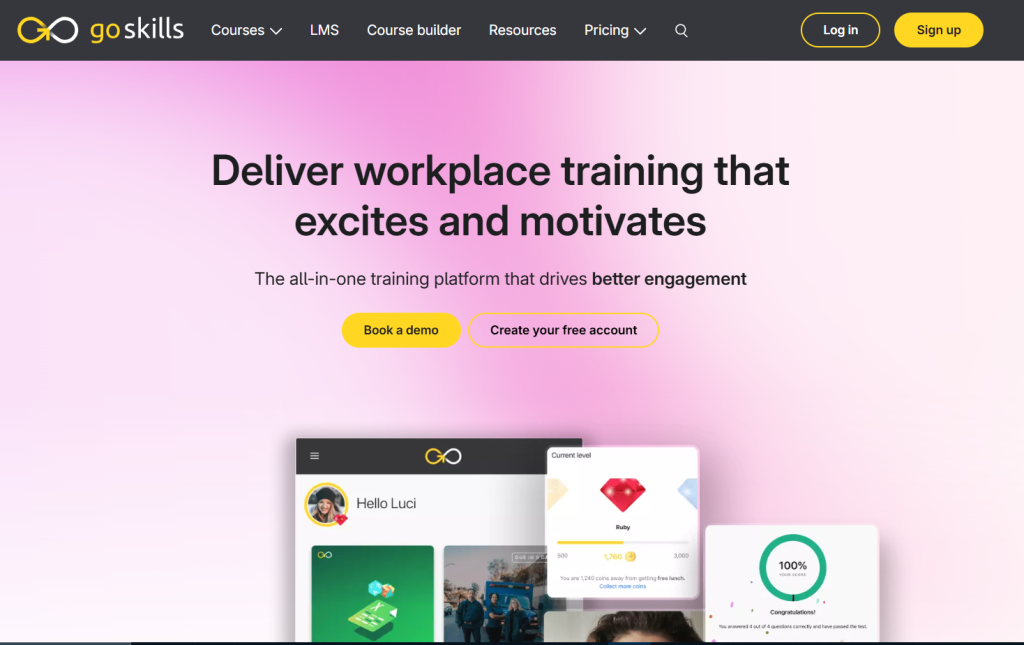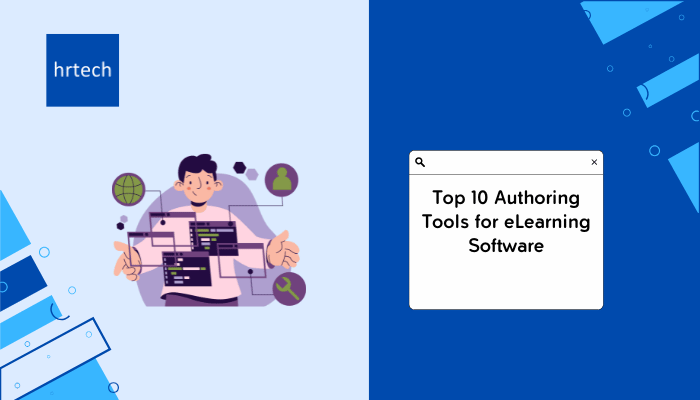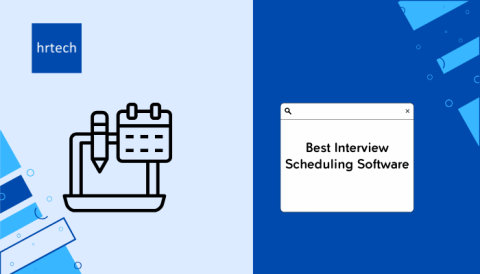The rise of e-learning software has transformed the way organizations deliver training and education, with the e-learning market expected to surpass $375 billion by 2026. As online education grows, so does the need for powerful authoring tools that simplify the creation of engaging, effective digital content.
These tools play a crucial role in helping educators, trainers, and instructional designers craft multimedia lessons, interactive activities, and assessments that enhance learning experiences.
In this guide, we’ll dive into the top 10 authoring tools for e-learning software, each equipped with unique features to meet diverse educational and training needs.
What are Authoring Tools, and Why Are They Essential?
Authoring tools are specialized software applications used to design, create, and publish digital learning content for e-learning software. These tools empower instructional designers, educators, and trainers to develop interactive multimedia content without extensive coding knowledge, making high-quality e-learning materials accessible and engaging.
In an e-learning market that’s projected to grow at a CAGR of 14.6% from 2021 to 2026, reaching a global value of $375 billion, the need for efficient authoring tools has never been greater. With these tools, educators can produce everything from simulations and quizzes to multimedia lessons that enhance learning retention.
Authoring tools streamline the design and delivery of online content, helping organizations to train employees faster and at a lower cost up to 50% less compared to traditional methods.
Why is SCORM and xAPI Compatibility Important?
SCORM (Sharable Content Object Reference Model) and xAPI (Experience API) are two essential standards for e-learning software that allow for content interoperability and data tracking. SCORM, developed in the early 2000s, ensures that e-learning content can function seamlessly across different Learning Management Systems (LMS).
This compatibility is vital for organizations that need flexible, scalable learning solutions, with SCORM-compatible courses remaining among the top requirements for LMS purchases. On the other hand, xAPI, a newer standard, captures learning activities beyond the LMS, tracking experiences in simulations, mobile apps, and even offline learning.
- Studies show that organizations that leverage xAPI capabilities see improvements in learner engagement and completion rates by up to 15%. Ensuring SCORM and xAPI compatibility within authoring tools allows for greater flexibility,
- comprehensive tracking, and the ability to meet modern e-learning standards, making these tools indispensable in today’s digital learning environments.
Key Features of Authoring Tools for e-Learning Software
Choosing the right e-learning software involves assessing various features that impact the efficiency and quality of your digital learning content. Here’s a breakdown of essential features to consider:
1. User-Friendly Interface
An intuitive interface is critical for authoring tools, allowing educators and designers to start building content quickly without a steep learning curve. Many tools offer a free trial period, which is an ideal way to assess how easily you can create, share, duplicate, and update content. A user-friendly interface can significantly reduce setup time and improve productivity.
- Simple navigation and layout
- Drag-and-drop functionality for quick content creation
- Minimal training required for new users
- Trial options to assess ease of use
2. Collaboration and Integration Capabilities
Collaborative features are essential for teams working together to produce and refine e-learning courses. Some tools allow multiple users to edit, review, and amend courses simultaneously, enhancing the course development process. Additionally, integration with other systems, like an LMS or digital asset management tools, makes it easy to reuse templates and assets, ensuring consistent branding across content.
- Multi-user access with role-based permissions
- Real-time collaborative editing and review functions
- Easy sharing of templates and brand assets
- LMS and digital asset management system integrations
3. Translation and Localization Features
For organizations reaching global audiences, translation and localization tools are essential. Many authoring tools now include translation workflows or auto-translate features, simplifying content adaptation for various languages. Some also support course variation functionality, allowing creators to manage and modify localized or translated versions efficiently.
- Translation workflows and auto-translate options
- Support for multiple languages and localized content
- Easy management of multiple versions for different regions
- Integrated glossary for consistent terminology across languages
4. Advanced Authoring Toolkit
A robust authoring toolkit helps create engaging and interactive learning experiences. Features like gamification, adaptive learning, and personalized learning pathways can improve learner engagement and retention. Reviewing example courses developed with each tool can provide insight into its capabilities.
- Options for gamification (e.g., badges, levels)
- Tools for personalized and adaptive learning pathways
- Interactive quiz and assessment capabilities
- Library of pre-built assets and interactive elements
5. Ready-Made Templates
Expert-designed templates streamline course creation, saving time and ensuring professional presentation. Templates often come with pre-built interactions, quizzes, and layouts that can be customized as needed. Reviewing available templates in advance can help determine how well they align with your content goals.
- Professionally designed templates for quick setup
- Pre-built interactions, quizzes, and modules
- Templates suited for various learning goals and formats
- Recommendations for template usage based on content type
6. Scope for Customization
Customization options allow designers to tailor the appearance and functionality of e-learning content. While some tools offer granular control over elements like colors, fonts, and layout positioning, they may be more complex to use. It’s helpful to review user feedback on customization features to find the right balance of flexibility and ease of use.
- Control over branding elements like colors, fonts, and logos
- Customizable layouts and course interfaces
- Options to create and save branded templates
- User feedback to gauge complexity and customization depth
7. Multi-Device Compatibility
Modern learners expect to access content seamlessly across devices, whether on desktop, tablet, or mobile. Multi-device compatibility ensures your e-learning software can deliver a responsive learning experience. Tools with automatic optimization features simplify the process of adapting content to various screen sizes.
- Responsive design for desktops, tablets, and mobile devices
- Minimal adjustments required for multi-device optimization
- Device preview options to check content on different screens
- Cross-platform compatibility for flexible access
These features are essential when selecting an authoring tool, ensuring that your chosen e-learning software supports efficient, engaging, and adaptable course creation.
Top 10 eLearning Authoring Tools
Choosing the right e-learning software is critical for developing high-quality, interactive learning experiences. Here’s a closer look at the top 10 authoring tools that help streamline the content creation process, each bringing unique features to enhance your e-learning strategy.
1. Easygenerator: All-in-One Software, No Coding Needed
Easygenerator simplifies the course creation process with its all-in-one platform, ideal for beginners and advanced users alike. It requires no coding knowledge, making it accessible to anyone in a training or instructional role. Users can develop interactive content and quizzes quickly, and its cloud-based interface allows for easy collaboration and content sharing.
- Drag-and-drop interface with real-time preview
- Content tracking for detailed learner insights
- Built-in collaboration tools
2. Gomo: Cloud-Based Authoring for Mobile-Optimized eLearning
Gomo is a versatile cloud-based e-learning software authoring tool that specializes in creating responsive, web-style content automatically optimized for mobile devices. Ideal for teams looking to produce accessible and collaborative content, Gomo allows users to design interactive courses that work seamlessly across devices. While its collaborative features are a standout, some users may encounter minor restrictions in authoring flexibility, which could require adjustments for specific content needs.
- Web-based content creation with automatic mobile optimization
- Collaboration features for team-based content development
- Real-time preview for responsive content across devices
3. Articulate Rise 360: Focus on Mobile-Responsive Content
Rise 360 from Articulate offers a mobile-first approach, ensuring content automatically adjusts to any screen size for a smooth learning experience across devices. It’s particularly useful for creating responsive courses quickly, making it a popular choice for modern, mobile-centric e-learning.
- Responsive content creation for all device types
- Simple drag-and-drop course builder
- Pre-built templates for rapid course assembly
- SCORM compatible for seamless LMS deployment
4. Adobe Captivate: Rich Features with Interoperability
Adobe Captivate is a powerful authoring tool favored for its comprehensive feature set, enabling the creation of complex, media-rich content. It offers high interoperability and supports multiple e-learning standards, making it adaptable to various LMSs. Advanced users will appreciate Captivate’s flexibility and depth.
- Supports SCORM, xAPI, and AICC for LMS integration
- VR and 360-degree media support for immersive learning
- Responsive content design for multi-device compatibility
- Built-in quiz and assessment tools
5. GoSkills LMS: A Flexible and Easy-to-Use Learning Management System

GoSkills LMS is designed for businesses and teams looking for an intuitive and scalable learning management system. Its user-friendly interface and seamless integrations make it easy to create, manage, and track training programs efficiently.
- User-friendly interface for seamless navigation
- SCORM and xAPI compliant for easy course integration
- Advanced analytics and reporting for tracking progress
- Integrates with business tools like Zapier and Slack
- Custom branding and white-label options for brand alignment
GoSkills LMS enables organizations to upskill their workforce effortlessly. With robust reporting and automation features, businesses can streamline training and monitor employee development in real time.
6. iSpring Suite: PowerPoint Conversion with Added Features
iSpring Suite allows users to turn PowerPoint presentations into interactive e-learning courses. It’s particularly useful for organizations already invested in PowerPoint, offering a straightforward way to enhance existing content with quizzes, video, and interactive features.
iSpring Suite is a fully stocked instructional development software that starts at $770 per user per year.
- Integrates seamlessly with PowerPoint
- Adds quizzes, video lectures, and simulations to slides
- Easy sharing and LMS integration options
7. Elucidat: Cloud-Based Rapid Production
Elucidat stands out for its rapid production capabilities, allowing teams to create, manage, and publish e-learning content at scale. Its cloud-based platform enables easy access and collaboration, while built-in analytics provide valuable insights into learner engagement and performance.
- Cloud-based for easy access and collaboration
- Real-time data tracking and analytics
- Extensive templates for streamlined content creation
8. Composica: Collaboration with Task Assignment
Composica is designed with collaboration in mind, making it a good fit for teams working together on course development. It includes task assignment features, enabling better workflow management and content development tracking. Composica also allows for customizable quizzes, gamification, and interactivity to enhance learning engagement.
- Task assignment for team collaboration
- Drag-and-drop interactivity and quiz customization
- Gamification elements for increased learner engagement
9. Knowbly: Drag-and-Drop Creation, Mobile-Responsive
Knowbly offers a simple drag-and-drop interface, making it easy to create interactive, mobile-responsive courses quickly. Its library of customizable templates allows users to design courses that meet brand standards while maintaining a responsive design for mobile learners.
- Intuitive drag-and-drop course builder
- Ready-made templates with customization options
- Built-in asset library for quick content creation
10. DominKnow ONE: Versatile Creation, Team Collaboration
DominKnow ONE combines content creation flexibility with team collaboration capabilities, allowing users to produce responsive content, videos, and quizzes all within a single platform. With cloud-based access, teams can collaborate on course development, and its versatile tools make it easy to adjust content for different learning goals.
- Cloud-based platform for remote collaboration
- SCORM, xAPI, and AICC compatible for LMS integration
- Responsive content creation for multi-device learning
- Built-in version control and tracking for smooth updates
Each of these e-learning software tools offers a unique set of features designed to simplify content creation, support multi-device learning, and ensure compatibility across LMSs. Selecting the right authoring tool depends on your team’s specific needs, desired output, and technical requirements, but all of these options provide robust solutions for delivering engaging, interactive e-learning experiences.
Evaluating the Best Authoring Tools for eLearning Software
When selecting an e-learning software authoring tool, it’s crucial to evaluate factors that impact both the creation process and the quality of the final learning experience. Key considerations include the quality of e-learning output, speed and efficiency of content production, and scalability for different audience sizes or training demands. Here’s a breakdown of these factors and how they influence the choice of authoring tools:
| Criteria | Description |
| Quality of eLearning Output | High-quality e-learning content should be visually engaging, interactive, and educationally effective. Look for tools that offer multimedia support, customizable templates, and responsive design to enhance learning impact. |
| Speed and Efficiency | Tools that simplify the creation process through intuitive interfaces, drag-and-drop features, and template libraries help reduce development time, enabling faster content delivery without sacrificing quality. |
| Scalability | Scalability ensures that the tool can handle content for a growing audience or increased course volume. Cloud-based platforms and collaborative features enable teams to expand content production to meet demand. |
Key Considerations for Choosing an Authoring Tool for eLearning Software
Selecting the right authoring tool for e-learning software goes beyond just functionality; it’s about finding a solution that aligns with your budget, support needs, and user experience requirements. Here are three critical factors to consider when evaluating e-learning authoring tools:
1. Cost Structure and Pricing Models
Authoring tools vary widely in pricing structures, from one-time license fees to subscription-based models and pay-per-user fees. Determining which pricing model fits your organization’s budget and usage patterns is essential. For smaller organizations or short-term projects, a monthly or annual subscription might provide flexibility, while larger organizations with ongoing e-learning development needs may benefit from a one-time license fee.
Some tools offer tiered pricing with different feature levels, allowing users to select the option that best matches their needs. Additionally, check for hidden fees, such as charges for additional storage, team collaboration, or advanced integrations, as these can significantly affect long-term costs.
- Pricing models: Subscription, one-time license, or pay-per-user
- Considerations: Hidden fees for advanced features or additional storage
- Tip: Explore free trials or demo versions to evaluate cost-effectiveness
2. Customer Support Availability
Reliable customer support is crucial when adopting e-learning software, as technical difficulties can disrupt course production timelines. Some authoring tools provide 24/7 support, while others may offer limited business-hour assistance or rely on knowledge bases and community forums. Assess the support channels available, such as live chat, email, or phone support, and consider whether premium support options are necessary for your team.
- Support channels: Live chat, email, phone, knowledge base, or community forums
- Availability: 24/7 support vs. business hours only
- Tip: Check for dedicated account managers or training options for larger implementations
3. Ease of Use for Content Creation
The usability of an authoring tool can greatly influence the speed and quality of e-learning content production. Look for tools with an intuitive, user-friendly interface, especially if your team includes users with varied technical expertise.
Features like drag-and-drop builders, pre-designed templates, and real-time previews can make content creation more straightforward, reducing the learning curve for new users. For organizations aiming to produce high-quality courses quickly, ease of use should be a priority, as complex tools may slow down development and require additional training.
- Interface: Drag-and-drop functionality, clear navigation, and real-time previews
- Customization: Pre-designed templates for faster course creation
- Tip: Seek user reviews or trial the tool to gauge the learning curve for your team
These considerations are essential in selecting an e-learning authoring tool that balances cost, support, and ease of use, ultimately enhancing the efficiency and quality of your content development process. Choosing the right e-learning software authoring tool can ensure sustainable, scalable, and impactful online learning experiences.
Conclusion
Selecting the right e-learning authoring tool is essential to create effective digital learning experiences tailored to your organization’s unique needs. While many authoring tools offer overlapping functionality, factors like content quality, scalability, and ease of use are key in refining your shortlist. For organizations focused on producing high-quality, scalable e-learning content, tools like Elucidat, with its rapid production and collaborative features, may be ideal.
To ensure the best fit, it’s important to conduct thorough research, explore user reviews, and take advantage of free trials or demos where possible. Testing the tool in a real-world context allows you to assess how well it aligns with your e-learning goals, technical requirements, and budget, giving you confidence in your final selection.
For expert guidance on optimizing your HR and training solutions, reach out to our team on the contact us page. We’re here to help you explore solutions that support your workforce development goals and strengthen your HR strategies.





